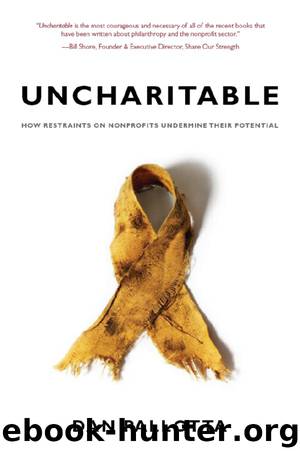Uncharitable by Dan Pallotta

Author:Dan Pallotta
Language: eng
Format: epub
Publisher: Tufts University Press
Discrimination Against Less Popular Causes
In the 1988 Riley case, the Supreme Court wrote of the statute in question that “the Act is impermissibly insensitive to the realities faced by small or unpopular charities, which must often pay more than 35% of gross receipts collected to the fundraiser due to the difficulty of attracting donors.”89 A charity whose cause is less popular than another will necessarily have to spend more money raising money. It is less expensive to raise large dollar amounts for a cause with which the wealthy sympathize than for one with which they don’t. A newly established charity will have all kinds of fundraising expenses that an established one won’t. Since efficiency measures are based in large part on fundraising costs, they inherently discriminate against less popular causes, causes with a less affluent constituency, and new charities.
Consider causes that have some stigma associated with them—suicide prevention or substance abuse, for instance. That stigma makes it harder for organizations working in these arenas to attract constituents and donors. Every October, major consumer brands like General Motors and Yoplait rally around the cause of breast cancer. How many corporations do we see making major sponsorships around issues like Native American substance abuse? How many large-scale, corporate-sponsored metropolitan walk-a-thons are devoted to obscure issues?
When a cause is less popular than others, every aspect of fundraising becomes more expensive. Instead of money flowing into the charity’s mailbox unsolicited and without any expense, as it can with a popular cause, organizations have to use a paid professional fundraising staff to go out and get it. They have to speak to donors more frequently and for a longer period of time. They have to spend more money on materials to educate potential donors about the cause, on research to find them, and a host of other things.
Consider a cause like breast cancer versus the cause of AIDS in Africa. Every year, about 180,000 American women are diagnosed with breast cancer, and about 40,000 women die. If every woman diagnosed with breast cancer has at least ten friends and family members in her closest circle, 1.8 million new Americans are intimately affected by the disease each year. If each of those people also has at least ten close friends and family members, that’s 18 million new Americans who know someone intimately affected each year. Add up ten years and you get 180 million Americans in that category—more than half the population. Add to this the fact that one in nine American women will be diagnosed with breast cancer in her lifetime, and there is almost no one who is not intimately affected. Many of us know someone who has died of breast cancer. This means it is much less difficult to get people to donate to breast cancer research than to some other, more obscure cause. How many of us know someone with AIDS in Africa?
Unknowingly, we conducted an important controlled experiment on this in 2001. That year we produced a series of breast cancer events and a series of AIDS Vaccine Rides.
Download
This site does not store any files on its server. We only index and link to content provided by other sites. Please contact the content providers to delete copyright contents if any and email us, we'll remove relevant links or contents immediately.
Pioneering Portfolio Management by David F. Swensen(6079)
Man-made Catastrophes and Risk Information Concealment by Dmitry Chernov & Didier Sornette(5647)
Zero to One by Peter Thiel(5489)
The Motivation Myth by Jeff Haden(5003)
The Miracle Morning by Hal Elrod(4422)
Elon Musk by Ashlee Vance(3854)
The Art of Persistence: Stop Quitting, Ignore Shiny Objects and Climb Your Way to Success by Michal Stawicki(3572)
Unlabel: Selling You Without Selling Out by Marc Ecko(3470)
Delivering Happiness by Tony Hsieh(3283)
Urban Outlaw by Magnus Walker(3242)
Purple Cow by Seth Godin(3069)
Mastering Bitcoin: Programming the Open Blockchain by Andreas M. Antonopoulos(2891)
The Marketing Plan Handbook: Develop Big-Picture Marketing Plans for Pennies on the Dollar by Robert W. Bly(2795)
The Content Trap by Bharat Anand(2778)
The Power of Broke by Daymond John(2774)
Applied Empathy by Michael Ventura(2752)
The Airbnb Story by Leigh Gallagher(2700)
Keep Going by Austin Kleon(2597)
Radical Candor by Kim Scott(2579)
